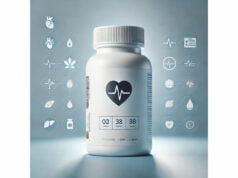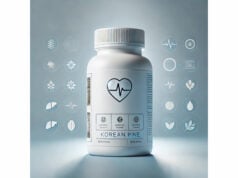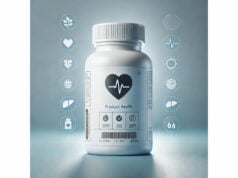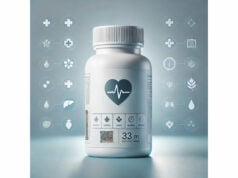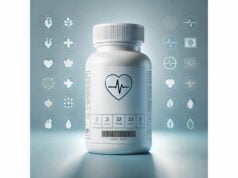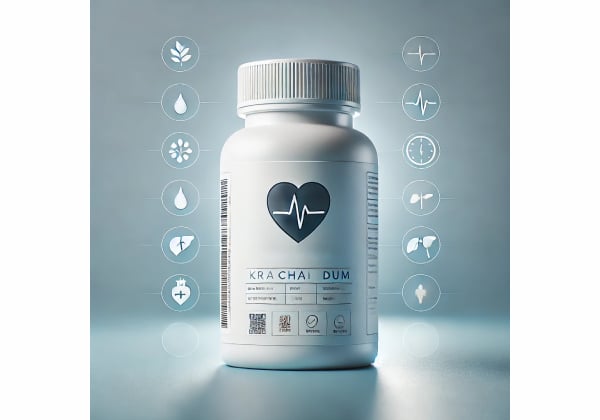
Krachai Dum—also known as black ginger or Kaempferia parviflora—is a Thai herb used for stamina, circulation, and vitality. Unlike culinary ginger, its deep-violet rhizome concentrates unique methoxyflavones that appear to influence blood flow, energy metabolism, and neuromuscular function. Early clinical trials suggest modest benefits for body composition and physical fitness, while laboratory work points to mechanisms relevant to glucose handling and endothelial function. As interest grows, so do questions: Which forms actually work? What dose makes sense? How long should you take it? What should you avoid if you’re on medicines? This guide gives you a practical, people-first overview—what Krachai Dum is, where it helps (and where evidence is thin), how to dose it safely, and the side effects to watch for—so you can make clear, informed choices with your clinician or sports professional.
Key Insights
- Human trials report support for abdominal fat reduction and cardiorespiratory fitness with standardized extracts over 8–12 weeks.
- Typical supplemental range: 90–360 mg/day of standardized extract (often 2.5–5% methoxyflavones); capsule labels vary.
- Caution with hypertension, thyroid disorders, anticoagulants, and stimulant combinations; stop before surgery.
- Avoid during pregnancy or breastfeeding; not for children unless a clinician specifically recommends and supervises.
Table of Contents
- What Krachai Dum is and how it works
- Does Krachai Dum really help
- How to use Krachai Dum correctly
- Variables that change results
- Side effects, interactions, and who should avoid
- Evidence check, data, and FAQs
What Krachai Dum is and how it works
Krachai Dum (Kaempferia parviflora) is a small Zingiberaceae (ginger family) plant native to Thailand. Traditional healers use the rhizome—freshly sliced, brewed as tea, or concentrated into tonics—for “wind,” stamina, and male vitality. Modern supplements most often provide a dry extract standardized to a group of compounds called methoxyflavones (notably 5,7-dimethoxyflavone and related molecules).
What makes it different from common ginger. Culinary ginger (Zingiber officinale) is dominated by gingerols and shogaols, which are pungent and warming. Black ginger concentrates methoxyflavones that are less about pungency and more about cellular signaling—with preliminary effects on nitric-oxide pathways, mitochondrial biogenesis, glucose uptake, and phosphodiesterase (PDE) inhibition in preclinical models. Those signals map to perceived benefits like improved blood flow, muscular endurance, and metabolic flexibility.
How the compounds might act (simplified).
- Circulation and endothelial tone: By nudging nitric-oxide availability and dampening oxidative stress, methoxyflavones may promote vasodilation in small vessels—one reason users report “warmth” in hands and feet during exercise.
- Mitochondrial and fuel selection effects: Extracts have been shown to shift substrate utilization toward fat oxidation in animal and in vitro studies, potentially supporting steady energy output at submaximal intensities.
- Glucose and insulin dynamics: Signals include modest improvements in glucose handling and adipocyte metabolism in preclinical work, aligning with body-composition findings in some human trials.
- Neuromuscular support: Mild PDE-related activity and ion-channel modulation could contribute to the “pep” people feel without the jitteriness of heavy stimulants—though sensitive users may still notice a lift similar to a strong cup of tea.
Forms you’ll see.
- Standardized extracts (capsules/tablets): Typically labeled by extract ratio and methoxyflavone content (e.g., 2.5–5%).
- Powdered rhizome: Less consistent; taste is earthy and slightly bitter.
- Functional drinks and shots: Often combine black ginger with caffeine, B-vitamins, or electrolytes—read labels closely.
- Topicals: Oils and balms for massage; systemic effects from topicals are minimal.
Who it might suit. Recreational and competitive athletes seeking a non-caffeinated performance nudge; adults working on abdominal fat and metabolic markers; people with cold extremities during training; and those preferring botanicals over harsher pre-workouts. Krachai Dum is not a fat-loss drug or a replacement for conditioning, sleep, and nutrition. Think of it as a supportive adjunct when the basics are in place.
Does Krachai Dum really help
What human studies suggest. In overweight adults, a 12-week course of standardized K. parviflora extract has been associated with reductions in abdominal fat, particularly visceral and subcutaneous compartments measured by imaging. In athletes and active individuals, randomized trials report improvements in cardiorespiratory fitness and selected physical performance metrics (e.g., time-to-exhaustion, Yo-Yo tests, or composite fitness scores) when taken daily for 8–12 weeks. A large adolescent sport-school trial using 360 mg/day found favorable shifts in physical fitness and autonomic balance under structured training.
Where results are strongest.
- Body composition: The most reproducible signal is a modest decrease in abdominal fat volume after daily intake for 8–12 weeks, without drastic changes in diet or training. Absolute reductions vary by baseline adiposity and extract potency; think subtle but meaningful rather than dramatic.
- Endurance and work capacity: Gains are most apparent in submaximal or intermittent efforts where improved oxidative metabolism helps maintain pace with less perceived exertion.
- Subjective energy and thermic comfort: Many users report steadier energy and warmer extremities during activity—consistent with vasodilation and fat-oxidation shifts.
Where evidence is mixed or limited.
- Acute effects: A single dose taken shortly before activity does not reliably enhance sprint or endurance performance. Benefits, when present, tend to accrue with daily intake over weeks.
- Strength and power: Data for one-rep max, jump height, or peak sprint power are limited and inconsistent.
- Glucose and lipids in diagnosed disease: Most trials enroll healthy or overweight volunteers. People with diabetes or dyslipidemia should not expect drug-like changes and should coordinate with their clinician.
How it likely compares with common ergogenics.
- Versus caffeine: Krachai Dum is gentler—fewer jitters, smaller heart-rate bump. It may pair well with lower caffeine doses or replace caffeine on easy days.
- Versus nitrates (beetroot): Both target vascular function but via different pathways; some athletes alternate or stack them, watching blood pressure and GI tolerance.
- Versus yohimbine or harsh thermogenics: Black ginger’s profile is milder; it favors consistency over acute stimulation.
Practical takeaway. Expect subtle, cumulative benefits after several weeks—especially for abdominal fat and aerobic fitness—provided you’re consistent with dosing and your program’s fundamentals (sleep, protein, fiber, progressive training) are solid.
How to use Krachai Dum correctly
Forms and label cues that matter.
- Look for the botanical name (Kaempferia parviflora), rhizome as the plant part, and a standardization (e.g., “≥2.5% total methoxyflavones” or a proprietary fingerprint).
- Extract ratios like 10:1 or 20:1 indicate starting biomass concentration but do not guarantee methoxyflavone content; standardization does.
Evidence-aligned daily ranges.
- Standardized extract: 90–360 mg/day, split once or twice daily. Common products supply 150–300 mg/day when standardized to ~2.5–5% methoxyflavones.
- Powdered rhizome (non-standardized): 1.0–1.5 g/day is often used traditionally, but potency varies widely; standardized extracts are preferred for predictability.
Timing.
- For training days, take 30–60 minutes pre-session if your stomach tolerates it; for general wellness, use morning or morning + early afternoon.
- Avoid late-evening dosing if you’re sensitive to mild stimulation or warming effects.
Dosing examples (illustrative, not prescriptions).
- New to black ginger: 100–150 mg once daily with the first meal for 1 week; if well tolerated, increase to 150 mg twice daily.
- Body-composition focus: 150–300 mg/day for 12 weeks, paired with a high-protein, high-fiber eating pattern and progressive resistance + zone-2 cardio.
- Endurance block: 150–300 mg/day through an 8–10 week build phase; consider pausing for a 1–2 week deload before your next block.
Cycling.
- Many athletes use 8–12 weeks on, then 2–4 weeks off to reassess. Carry a simple log: dose, training, sleep, perceived energy, heart rate, and any side effects.
Stacking pointers.
- Pairs well with: beetroot/nitrates (on different days), creatine, beta-alanine, electrolytes, magnesium, L-citrulline (monitor blood pressure if you combine vasodilatory agents).
- Use caution with: high-dose caffeine, yohimbine, synephrine, or other strong stimulants—watch for palpitations or blood-pressure spikes.
- Medication spacing: separate by 3–4 hours from narrow-therapeutic-index drugs if your clinician advises (e.g., thyroid hormone, certain antibiotics).
What “success” looks like in 4–12 weeks.
- Slightly easier aerobic efforts at a given pace/HR, warmer hands/feet during workouts, less central fatigue on long days, and modest waist changes (especially when sleep and protein intake improve).
When to stop or adjust.
- New or worsening headaches, palpitations, elevated blood pressure, insomnia, GI upset, rash, or any concerning symptom.
- If you see no meaningful change after 8–12 weeks with good adherence, discontinue and re-focus on training and diet levers with better ROI.
Variables that change results
1) Standardization and extract chemistry. Not all products are equal. Two capsules labeled “300 mg black ginger” may differ in methoxyflavone content by several fold. Human outcomes tend to track with total methoxyflavones rather than raw milligrams. If a label lists 5,7-dimethoxyflavone or a total methoxyflavone percentage, you’re already ahead.
2) Dose relative to body size and training load. Larger athletes or those in heavy endurance blocks often respond better to the upper half of the 90–360 mg/day range, while smaller or stimulant-sensitive people may do best at 100–150 mg/day. Always titrate by tolerance and blood-pressure checks if you’re prone to hypertension.
3) Baseline diet and sleep. Black ginger’s metabolic support shows best when protein (1.6–2.2 g/kg/day), fiber (25–35 g/day), and 7–9 hours of sleep are in place. Poor sleep blunts nearly every supplement’s benefit profile.
4) Training match. Expect clearer effects in submaximal efforts (zone-2/tempo runs, longer rides, circuits) than in pure anaerobic or max-power sessions. If your sport is sprint-dominant, improvements may be subtle.
5) Health context. In people with well-controlled cardiometabolic status, changes are often modest but noticeable; in diagnosed disease, let your clinician guide expectations. Do not alter prescribed medications without medical input.
6) Stacks and timing with vasodilators. Combining black ginger with nitrates, citrulline, or ACE-inhibiting herbs can drop blood pressure in sensitive users. Start low and monitor. For caffeine users, many find that lower caffeine + black ginger yields smoother energy with fewer jitters.
7) Product quality. Choose brands that disclose:
- Botanical identity and part used (rhizome),
- Standardization (e.g., total methoxyflavones),
- Batch testing for heavy metals, microbes, and adulterants, and
- Manufacturing dates and lot numbers for traceability.
8) Time horizon and assessment. Track resting HR, RPE at a fixed pace, waist circumference, or submaximal time-to-exhaustion every 2–4 weeks. If nothing moves after 8–12 weeks, consider reallocating budget to coaching, sleep optimization, or nutrition.
9) Individual sensitivity. A minority feel warm, restless, or headachy at higher doses; others feel nothing until week 3–4. Personal response matters—data from your own log should be the tiebreaker.
Side effects, interactions, and who should avoid
Common, usually mild effects (often dose-related).
- GI: upset stomach, loose stools, or mild heartburn—improve with food-based dosing or dose reduction.
- CNS: wired or “warm” sensation, light headache, restlessness if taken late.
- Skin/sinuses: flushing or warmth, especially in hot environments.
Less common but important.
- Blood pressure or heart rate changes: particularly when stacked with stimulants or vasodilators.
- Sleep disruption: avoid evening doses if you’re sensitive.
- Allergy: rare; stop immediately with hives, wheeze, or swelling.
- Liver markers: modern human trials report good short-term tolerance; if you have liver disease, get baseline and follow-up labs when starting any new supplement.
Medication and condition cautions.
- Hypertension or cardiovascular disease: start at the low end, monitor BP/HR, and clear use with your clinician—especially if you take beta-blockers, calcium-channel blockers, or nitrates.
- Thyroid disorders: stimulant sensitivity can be higher; coordinate with your endocrinologist.
- Anticoagulants or antiplatelets: theoretical interaction via endothelial and platelet pathways; discuss timing and monitoring with your prescriber.
- Diabetes medications: while dramatic glucose changes are unlikely, check home readings when adding any metabolic botanical.
- Surgery or dental procedures: stop 7–10 days beforehand unless your surgeon advises otherwise.
Who should avoid unless specifically cleared.
- Pregnant or breastfeeding individuals.
- Children and adolescents unless a clinician supervises and a clear indication exists.
- People with uncontrolled hypertension, unstable arrhythmias, or active peptic ulcer.
- Anyone with known allergy to Zingiberaceae botanicals (rare but possible).
Stop and seek care if you experience chest pain, severe palpitations, fainting, shortness of breath, jaundice, or signs of an allergic reaction.
Bottom line. Krachai Dum is generally well tolerated in short human trials when used at 90–360 mg/day of standardized extract, but smart screening, conservative dosing, and attention to stacking keep it that way.
Evidence check, data, and FAQs
What recent studies say in plain language.
- A systematic review and meta-analysis combining animal and human data reports beneficial effects on metabolic-syndrome markers and erectile-function outcomes, supporting the herb’s cardiometabolic and vascular reputation.
- A randomized, placebo-controlled trial in overweight adults found that daily black ginger extract for 12 weeks reduced abdominal fat, measured with imaging, versus placebo.
- In athletes and active individuals, randomized trials and controlled programs report improved physical fitness after 8–12 weeks of daily intake—aligning with endurance-support observations from preclinical work.
- Safety programs, including sub-chronic and mutagenicity testing, show a good tolerance profile in the tested dose ranges, and 4-week human safety trials report no serious adverse signals in healthy subjects.
What that means for you.
- If your goal is abdominal fat and cardio fitness, a standardized extract taken daily for 8–12 weeks may offer modest, additive benefits—provided you maintain consistent training and nutrition.
- If you want a day-of performance boost for sprints or a time trial, black ginger is unlikely to help on its own; it’s a build-phase tool, not a race-day secret.
FAQs
How long before I notice anything? Many users notice warmer extremities or steadier energy in 1–2 weeks; measurable changes in fitness or waist often need 8–12 weeks.
Can I combine it with caffeine? Yes, but start with lower caffeine (e.g., 50–100 mg) and 150–200 mg black ginger to gauge BP/HR and sleep.
Do I need to cycle? Not mandatory. A pragmatic plan is 8–12 weeks on, 2–4 weeks off, then reassess.
What’s the best time to take it? Morning or pre-workout (30–60 minutes). Avoid late evening if sleep is sensitive.
Is the powder as good as extract? Predictability is the issue. For consistent outcomes, choose standardized extracts that disclose methoxyflavone content.
Can it help with erectile performance? The vascular and endothelial signals make it biologically plausible, and meta-analytic data include erectile-function endpoints. Discuss with your clinician—especially if you take nitrates or have cardiovascular disease.
How do I vet a product? Prefer brands with third-party testing, transparent standardization, and clear lot numbers. Avoid proprietary blends that hide amounts.
When should I not use it? During pregnancy/breastfeeding, before surgery, with uncontrolled hypertension, or alongside heavy stimulant stacks. When in doubt, ask your clinician.
Practical bottom line. Krachai Dum isn’t a magic bullet. As a daily, standardized extract layered onto solid training and nutrition, it can be a useful adjunct for endurance comfort and abdominal fat reduction—with a safety profile that’s favorable when you dose sensibly and monitor how you feel.
References
- A systematic review and meta-analysis of animal and human studies demonstrates the beneficial effects of Kaempferia parviflora on metabolic syndrome and erectile dysfunction 2024 (Systematic Review)
- Daily intake of Kaempferia parviflora extract decreases abdominal fat in overweight and preobese subjects: a randomized, double-blind, placebo-controlled clinical study 2018 (RCT)
- Effect of Kaempferia parviflora Extract on Physical Fitness of Soccer Players 2015 (Randomized Controlled Trial)
- Kaempferia parviflora Extract (SIRTMAX®) reduces body fat in adults who are overweight: a 12-week randomized, double-blind, placebo-controlled trial 2025 (RCT)
- Antiobesity effect of Kaempferia parviflora accompanied by gastrointestinal and hepatic modulation in high-fat diet-induced obesity 2023 (Preclinical)
Disclaimer
This guide is for general education and is not a substitute for personalized medical advice, diagnosis, or treatment. Always consult a qualified healthcare professional before starting any new supplement, especially if you are pregnant, breastfeeding, have cardiovascular, endocrine, or liver conditions, or take prescription medicines. If you experience chest pain, severe headache, palpitations, shortness of breath, allergic symptoms, or other worrisome effects after taking Krachai Dum, stop use and seek medical care. If you found this article helpful, please consider sharing it on Facebook, X (formerly Twitter), or your preferred platform, and follow us for more evidence-based wellness content. Your support helps us continue creating high-quality resources.

